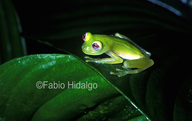|
Hyalinobatrachium dianae Kubicki, Salazar & Puschendorf, 2015
Diane's bare-hearted glassfrog, rana de vidrio de Diane | family: Centrolenidae subfamily: Hyalinobatrachinae genus: Hyalinobatrachium |
| Species Description: Kubicki B, Salazar S, Puschendorf R 2015 A new species of glassfrog, genus Hyalinobatrachium (Anura: Centrolenidae), from the Caribbean foothills of Costa Rica. Zootaxa 3920: 69-84. | |
 © 2015 Fabio Hidalgo (1 of 5) |
|
|
|
Description This species can be distinguished from other centrolenids by the characteristics mentioned in the above description. Furthermore, its lack of yellow spots on the back distinguishes it from the following Hyalinobatrachium species: H. anachoretus, H. aureoguttatum, H. chirripoi, H. colymbiphyllum, H. fleischmanni, H. talamancae, H. vireovittatum. Additionally, H. talamancae and H. vireovittatum have green stripes running down the midline of their back. Hyalinobatrachium dianae can furthermore be distinguished from H. valerioi, which has a netted pattern on its back, and H. pellucidum, which only has a single tonal note call (Kubicki et al. 2015). In life, the back is lime green, and has no yellow spots. The granules on the back are a bit lighter in color than the back itself. The hands and feet are pale green-yellow. The background of the iris is white, though there are also minute dark spots present, which become more concentrated around the pupil. The tubercles underneath the cloaca are faintly white in color. The aforementioned ovate structure on the backside of the pelvis is black. The underside is transparent, and the bones are white. The liver and digestive organs are surrounded by a white lining. The heart and veins are red, as are the blood vessels surrounding the transparent lungs. The gall bladder is yellow and transparent. In preservative, the back is pale and creamy yellow, and the only discernible color features of the back are the diffused minute black spots and the black ovate structure by the pelvis (Kubicki et al. 2015). The previously described dark ovate structure on the backside of the pelvis may differ in its orientation, being located just off to the right or to the left of the midline of the body (Kubicki et al. 2015). Distribution and Habitat Country distribution from AmphibiaWeb's database: Costa Rica
Life History, Abundance, Activity, and Special Behaviors Only the holotype advertisement call has been analyzed. At 22.7oC, he had a long metallic whistle-like advertisement call. It is very fast but the intensity is weak. Note durations are 0.40 - 0.55 s and the dominate frequency was 3.35 - 3.44 kHz (Kubicki et al. 2015). Trends and Threats Relation to Humans Comments Hyalinobatrachium dianae is sister to H. chirripoi and H. colymbiphyllum. Together, these three species are sister to H. talamancae and H. vireovittatum. In all, these five species are sister to H. valerioi and H. fleischmanni (Kubicki et al. 2015). The species epithet dianae is dedicated to the senior author’s mother, Janet Diane Kubicki, who was influential in supporting the author’s passion for natural history, fishes, and amphibians. It is also a reference to Diana, the Roman goddess of the hunt, who resided in forested mountains, much like the authors’ pursuit of amphibians within the forested mountains of Costa Rica (Kubicki et al. 2015). This frog has been featured on social media for its resemblance to Kermit the Frog, a character from The Muppet Show (Gannon 2015).
References
Gannon, M. “Kermit the Frog Look-Alike Discovered in Costa Rica”. LiveScience. www.livescience.com. 22 April 2015. Kubicki, B., Salazar, S., Puschendorf, R. (2015). ''A new species of glassfrog, genus Hyalinobatrachium (Anura: Centrolenidae), from the Caribbean foothills of Costa Rica.'' Zootaxa, 3920(1), 69-84. Originally submitted by: Alex Shepack (first posted 2015-07-07) Edited by: Gordon Lau (2015-08-03) Species Account Citation: AmphibiaWeb 2015 Hyalinobatrachium dianae: Diane's bare-hearted glassfrog <https://amphibiaweb.org/species/8312> University of California, Berkeley, CA, USA. Accessed Jun 15, 2025.
Feedback or comments about this page.
Citation: AmphibiaWeb. 2025. <https://amphibiaweb.org> University of California, Berkeley, CA, USA. Accessed 15 Jun 2025. AmphibiaWeb's policy on data use. |



 Map of Life
Map of Life